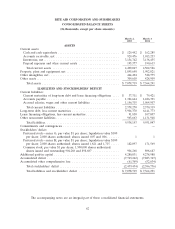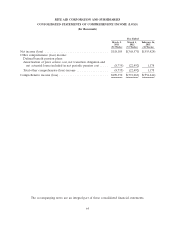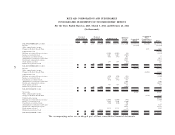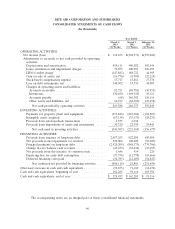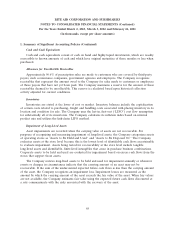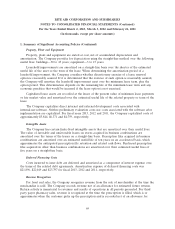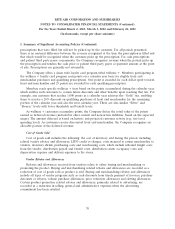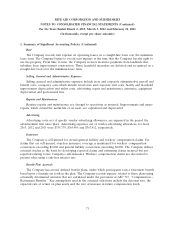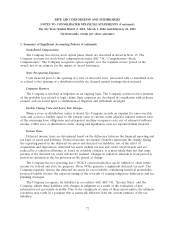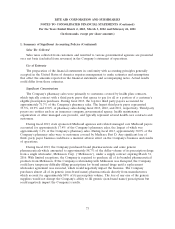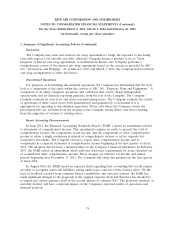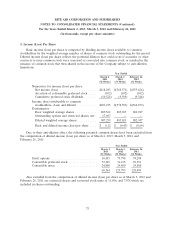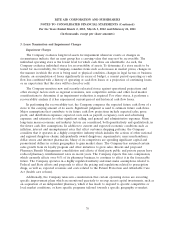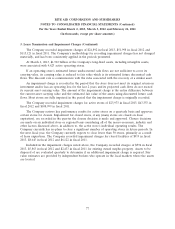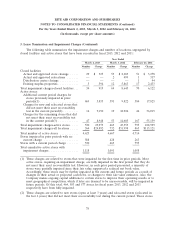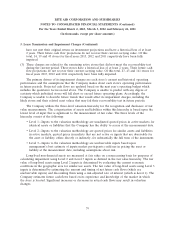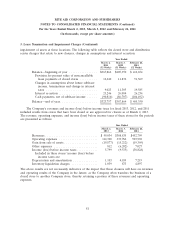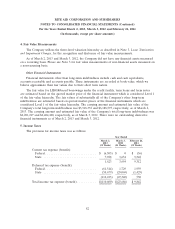Rite Aid 2013 Annual Report Download - page 73
Download and view the complete annual report
Please find page 73 of the 2013 Rite Aid annual report below. You can navigate through the pages in the report by either clicking on the pages listed below, or by using the keyword search tool below to find specific information within the annual report.RITE AID CORPORATION AND SUBSIDIARIES
NOTES TO CONSOLIDATED FINANCIAL STATEMENTS (Continued)
For the Years Ended March 2, 2013, March 3, 2012 and February 26, 2011
(In thousands, except per share amounts)
1. Summary of Significant Accounting Policies (Continued)
Stock-Based Compensation
The Company has several stock option plans, which are described in detail in Note 15. The
Company accounts for stock-based compensation under ASC 718, ‘‘Compensation—Stock
Compensation.’’ The Company recognizes option expense over the requisite service period of the
award, net of an estimate for the impact of award forfeitures.
Store Pre-opening Expenses
Costs incurred prior to the opening of a new or relocated store, associated with a remodeled store
or related to the opening of a distribution facility are charged against earnings when incurred.
Litigation Reserves
The Company is involved in litigation on an ongoing basis. The Company accrues its best estimate
of the probable loss related to legal claims. Such estimates are developed in consultation with in-house
counsel, and are based upon a combination of litigation and settlement strategies.
Facility Closing Costs and Lease Exit Charges
When a store or distribution center is closed, the Company records an expense for unrecoverable
costs and accrues a liability equal to the present value at current credit adjusted risk-free interest rates
of the remaining lease obligations and anticipated ancillary occupancy costs, net of estimated sublease
income. Other store or distribution center closing and liquidation costs are expensed when incurred.
Income Taxes
Deferred income taxes are determined based on the difference between the financial reporting and
tax basis of assets and liabilities. Deferred income tax expense (benefit) represents the change during
the reporting period in the deferred tax assets and deferred tax liabilities, net of the effect of
acquisitions and dispositions. Deferred tax assets include tax loss and credit carryforwards and are
reduced by a valuation allowance if, based on available evidence, it is more likely than not that some
portion of the deferred tax assets will not be realized. Changes in valuation allowances from period to
period are included in the tax provision in the period of change.
The Company has net operating loss (‘‘NOL’’) carryforwards that can be utilized to offset future
income for federal and state tax purposes. These NOLs generate a significant deferred tax asset. The
Company regularly reviews the deferred tax assets for recoverability considering historical profitability,
projected taxable income, the expected timing of the reversals of existing temporary differences and tax
planning strategies.
The Company recognizes tax liabilities in accordance with ASC 740, ‘‘Income Taxes’’ and the
Company adjusts these liabilities with changes in judgment as a result of the evaluation of new
information not previously available. Due to the complexity of some of these uncertainties, the ultimate
resolution may result in a payment that is materially different from the current estimate of the tax
liabilities.
72


